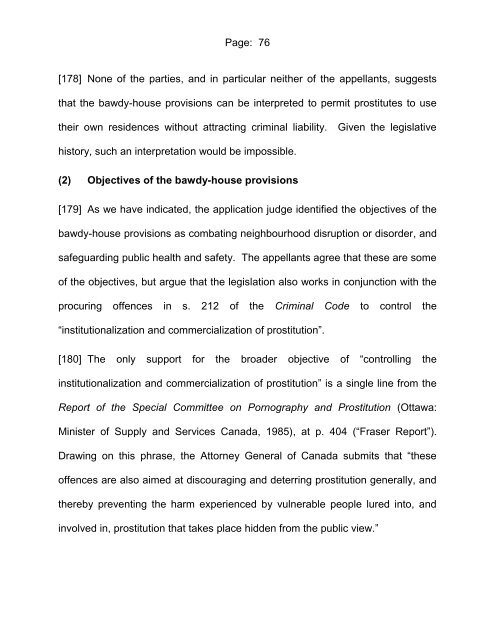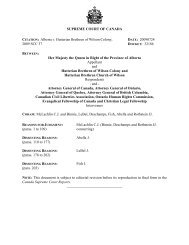Canada (Attorney General) v. Bedford, 2012 ONCA ... - York University
Canada (Attorney General) v. Bedford, 2012 ONCA ... - York University
Canada (Attorney General) v. Bedford, 2012 ONCA ... - York University
You also want an ePaper? Increase the reach of your titles
YUMPU automatically turns print PDFs into web optimized ePapers that Google loves.
Page: 76[178] None of the parties, and in particular neither of the appellants, suggeststhat the bawdy-house provisions can be interpreted to permit prostitutes to usetheir own residences without attracting criminal liability. Given the legislativehistory, such an interpretation would be impossible.(2) Objectives of the bawdy-house provisions[179] As we have indicated, the application judge identified the objectives of thebawdy-house provisions as combating neighbourhood disruption or disorder, andsafeguarding public health and safety. The appellants agree that these are someof the objectives, but argue that the legislation also works in conjunction with theprocuring offences in s. 212 of the Criminal Code to control the“institutionalization and commercialization of prostitution”.[180] The only support for the broader objective of “controlling theinstitutionalization and commercialization of prostitution” is a single line from theReport of the Special Committee on Pornography and Prostitution (Ottawa:Minister of Supply and Services <strong>Canada</strong>, 1985), at p. 404 (“Fraser Report”).Drawing on this phrase, the <strong>Attorney</strong> <strong>General</strong> of <strong>Canada</strong> submits that “theseoffences are also aimed at discouraging and deterring prostitution generally, andthereby preventing the harm experienced by vulnerable people lured into, andinvolved in, prostitution that takes place hidden from the public view.”
















